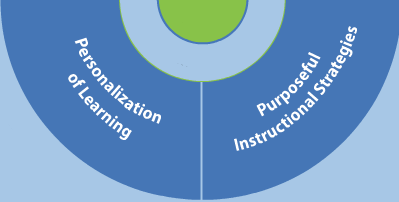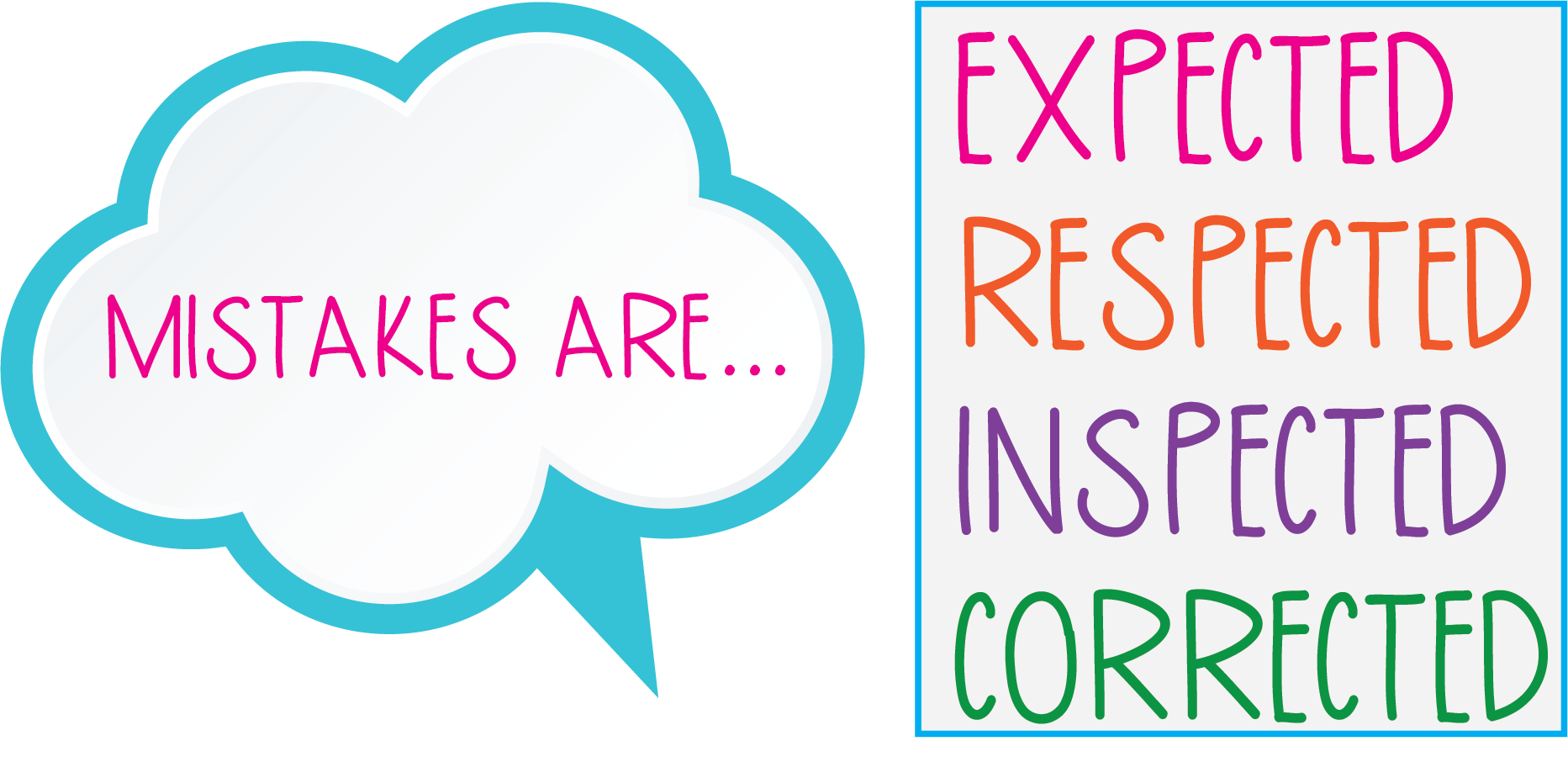
Numerate Environment
Mistakes and Productive Struggle are Valuable
What does this mean?
What does this mean?
How many of your students and parents believe the goal of learning math is to get the right answer?
“Helping students to learn from their mathematical mistakes can give us insight into their misconceptions and, depending on our instructional reactions, can enable them to develop deeper understanding of the mathematics they are learning. Meaningful assistance encompasses more than fixing a careless error related to poor study habits, such as misreading directions, miscopying a numeral, or forgetting a sign. Although we can easily and explicitly address careless errors in our instruction, it can be more challenging—but potentially much more rewarding—to address errors that fall into the special category of productive mistakes. These are the mistakes that have the potential to promote rich learning.”
“How we respond to productive errors can encourage or discourage student thinking and learning (Gojak, 2013).


Representation of Boaler’s Mistakes Poster as cited in Ferlazzo, 2016
How do I Support This?
CONSIDER
Honor Mistakes through the Learning Atmosphere
- Creating a classroom norm that includes “mistakes are a part of learning” (Sun, 2018; Boaler, 2016)
“Emphasizing mathematical norms that promote sharing one’s ways of thinking even if it may not be correct” (Middleton, Hatfield & Tallman, 2015, p. 6)
- Providing opportunities so students are able to make mistakes. Consider the challenge of the tasks presented. High challenge tasks with appropriate supports that may include:
- choice of task difficulty,
- variety of ways to demonstrate understanding
- the availability of tools and other material resources to solve the tasks (Middleton, Hatfield & Tallman, 2015)
- Asking students to explain their reasoning about whether an answer is correct of incorrect (Gojack, 2013). For example:

Trying the inverted test to promote the ideas that mistakes are valuable. Give students a test (or question) completed by a fictitious student who did not do very well. Ask student to correct the fictitious student’s test by:
- Identifying the mistakes made,
- Explaining each mistake and how they would approach the solution,
- And identifying 3what the fictitious student did well.
Assess students on how many mistakes they identified and how well they explained the mistakes. “Remind students that when they get their own tests and homework back they should do the same thing – look for and learning from mistakes” (PERTS, 2015).
Provide Timely Feedback so Mistakes can be Responded to
- Recognizing that the earlier a problem is discovered, the easier it is to fix. (Heick, 2019)
- Embedding the norm of math learning as “practice activities, make errors, get feedback, think over the feedback, and try again” (Heick, 2019, p. 5)
- Following productive errors with probing questions that offer students different approaches for reflecting on their thinking (Gojak, 2013)
Analyze Root Causes and Sources of Mistakes
- Taking the time to analyze students’ errors, both written and oral, to determine misconceptions that students might have and how you can address those misconceptions (Gojack, 2013).
- Determining if the mistake is a careless mistake, systematic mistake or a misconception. Provide feedback on where the mistake lies.
Promote Persistence
- Assigning a smaller number of carefully selected problems, with the expectation of having student devote more time to reasoning and making sense of the outcomes. Give students time and space to grapple with meaningful math tasks and not “spoon-feeding” our students through problems when they struggle (Suh et. Al, 2011; Gojak, 2013).
Using a “set of prompts to encourage learners to reflect orally or in writing about their use of communication, flexible thinking, and persistence as they approached mathematical tasks…have students respond to a particular column or row in the chart provided or give student choices about which prompts to use (Suh et. Al, 2011, see p. 172 for a copy of the chart to use with students) or see chart below:
Clear Communication
What math words could help us share our thinking about this problem? Choose 2 and explain what they mean in your own words.
What could you use besides words to show how to solve this problem? Explain how this representation would help someone understand.
If you needed to make your work easier for someone else to understand, what would you change?
Respectful Communication
Did someone else solve the problem in a way you had not thought of? Explain what you learned by listening to a classmate.
Did you ask for help or offer to help a classmate? Explain how working together helped solve the problem.
What helped you share and listen respectfully when we discussed the problem? or What do you need to change so that you can share and listen respectfully next time?
Flexible Thinking
What other problems or math topics does this remind you of? Explain your connection.
Briefly describe at least 2 ways to solve the problem. Which is easier for you?
What strategies did you use that you think will be helpful again for future problems?
Persistence
What did you do if you got stuck or felt frustrated?
What helped you try your best? or what do you need to change so that you can try your best next time?
Do you feel more or less confident about math after trying this problem? Explain why.
Teacher Professional Learning Resources:
Resources to use with your Class and Students:
Children’s Literature
“The Girl Who Never Made Mistakes” by Mark Pett & Gary Rubinstein
”I Can’t Do That, Yet: Growth Mindset” by Esther P. Cordova
Bibliography and Further Reading
Boaler, J. (2016). Mathematical mindsets: unleashing students potential through creative math, inspiring messages, and innovative teaching. San Francisco, CA: Jossey-Bass & Pfeiffer Imprints.
Ferlazzo, L. (2016, September 22). Response: Mistakes Are ‘Learning in Action’. Retrieved January 23, 2020, from http://blogs.edweek.org/teachers/classroom_qa_with_larry_ferlazzo/2016/09/response_mistakes_are_learning_in_action.html
Gojak, L. (2013, January 8). The Power of a Good Mistake. Retrieved September 28, 2019, from https://www.nctm.org/News-and-Calendar/Messages-from-the-President/Archive/Linda-M_-Gojak/The-Power-of-a-Good-Mistake/.
Heick, T. (2019, July 31). 9 Ways To Help Students Learn Through Their Mistakes. Retrieved January 23, 2020, from https://www.teachthought.com/pedagogy/9-ways-help-students-learn-mistakes/
PERTS. (2015). A growth mindset means embracing challenge and mistakes. Retrieved October 27, 2019, from https://www.mindsetkit.org/practices/xrsBxcAgzTictvnb
Suh, J., Graham, S., Ferrarone, T., Kopeinig, G., & Bertholet, B. (2011). Developing Persistent and Flexible Problem Solvers with a Growth Mindset. In Motivation and Disposition: Pathways to Learning Mathematics, seventy-third yearbook. Retrieved from http://mason.gmu.edu/~jsuh4/tenure/part4thru8/papers/YB_chap_12_p169-184.pdf
Sun, K. L. (2018). The Role of Mathematics Teaching in Fostering Student Growth Mindset. Journal for Research in Mathematics Education, 49(3), 330–355.



